Руководство по использованию
1. Особенности
- Отсчет времени, до 10 часов;
- Настраиваемый обратный отсчет, до 10 часов;
- Звуковой сигнал при окончании матча;
- Питание: 1 батарейка АА (1.5 В).
2. Инструкция

1 [Влево/Вправо], 2 [+], 3[Старт / Пауза / Настройка], 4[-], 5[ON/OFF], 6[Экран], 7[Крышка батарейного отсека]
3.
3. Инструкция по эксплуатации
3.1.ON/OFF
Вставьте батарейку, сдвиньте переключатель [ON/OFF], в положение ON; чтобы выключить – переведите в положение OFF.
3.2.Отсчет времени
Включившись, часы выведут на дисплее «0». Это начальная точка отсчета времени. Нажмите [Влево/Вправо], чтобы начать отсчет времени в партии.
3.3.Обратный отсчет
a. Находясь на экране отсчета времени, нажмите и удерживайте [Старт/Пауза/Настройка] в течение 3 секунд, чтобы перейти к настройкам обратного отсчета – замигает число часов; с помощью кнопок [+] и [–] задайте желаемое значение и нажмите [Старт/Пауза/Настройка] и задайте число минут, затем секунд. Установив значения, удерживайте [Старт/Пауза/Настройка] в течение 3 секунд, чтобы вернуться к экрану обратного отсчета.
b. Нажмите [Влево/Вправо], чтобы начать партию. Игрок, у которого закончилось время, проигрывает, отсчет времени останавливается и звучит 2-секундный звуковой сигнал.
3.4.Пауза
Во время отсчета времени нажмите [Старт/Пауза/Настройка], чтобы приостановить отсчет времени. Нажмите еще раз, чтобы продолжить отсчет.
3.5.Перезапуск
Во время паузы или по окончании матча нажмите и удерживайте [Старт/Пауза/Настройка] в течение 3 секунд, чтобы сбросить значения таймера. Вы можете начать матч с начала.
Примечание: Если изображение на дисплее стало нечетким, а кнопка [Влево/Вправо] перестала работать, замените элементы питания.
4. Уход за устройством
4.1.Не подвергайте воздействию высоких температур и прямых солнечных лучей.
4.2.Избегайте контактов с коррозийными жидкостями и острыми предметами.
4.3.Не ставьте рядом с источниками статического напряжения.
Стандарт № GB/T22778-2008
Руководство по использованию
1. Особенности
- Отсчет времени, до 10 часов;
- Настраиваемый обратный отсчет, до 10 часов;
- Звуковой сигнал при окончании матча;
- Питание: 1 батарейка АА (1.5 В).
2. Инструкция

1 [Влево/Вправо], 2 [+], 3[Старт / Пауза / Настройка], 4[-], 5[ON/OFF], 6[Экран], 7[Крышка батарейного отсека]
3.
3. Инструкция по эксплуатации
3.1.ON/OFF
Вставьте батарейку, сдвиньте переключатель [ON/OFF], в положение ON; чтобы выключить – переведите в положение OFF.
3.2.Отсчет времени
Включившись, часы выведут на дисплее «0». Это начальная точка отсчета времени. Нажмите [Влево/Вправо], чтобы начать отсчет времени в партии.
3.3.Обратный отсчет
a. Находясь на экране отсчета времени, нажмите и удерживайте [Старт/Пауза/Настройка] в течение 3 секунд, чтобы перейти к настройкам обратного отсчета – замигает число часов; с помощью кнопок [+] и [–] задайте желаемое значение и нажмите [Старт/Пауза/Настройка] и задайте число минут, затем секунд. Установив значения, удерживайте [Старт/Пауза/Настройка] в течение 3 секунд, чтобы вернуться к экрану обратного отсчета.
b. Нажмите [Влево/Вправо], чтобы начать партию. Игрок, у которого закончилось время, проигрывает, отсчет времени останавливается и звучит 2-секундный звуковой сигнал.
3.4.Пауза
Во время отсчета времени нажмите [Старт/Пауза/Настройка], чтобы приостановить отсчет времени. Нажмите еще раз, чтобы продолжить отсчет.
3.5.Перезапуск
Во время паузы или по окончании матча нажмите и удерживайте [Старт/Пауза/Настройка] в течение 3 секунд, чтобы сбросить значения таймера. Вы можете начать матч с начала.
Примечание: Если изображение на дисплее стало нечетким, а кнопка [Влево/Вправо] перестала работать, замените элементы питания.
4. Уход за устройством
4.1.Не подвергайте воздействию высоких температур и прямых солнечных лучей.
4.2.Избегайте контактов с коррозийными жидкостями и острыми предметами.
4.3.Не ставьте рядом с источниками статического напряжения.
Стандарт № GB/T22778-2008
Содержание
- Шахматные часы LEAP Easy PQ9907S
- Как работают шахматные часы? Полное руководство
- Как работают шахматные часы?
- Типы шахматных часов
- 1. Песочные часы
- 2. Аналоговые часы
- 3. Цифровые часы
- Особенности шахматных часов
- Основные требования к шахматным часам
- Шахматная сумка








Поддерживают классический контроль времени (счёт по убывающей), а также контроль времени с добавлением (Фишера) и контроль с задержкой. За несколько секунд до окончания времени, и в момент окончания издаётся звуковой сигнал (функцию можно отключить).
Характеристики:
- Время отображается на двух хорошо читаемых монохромных дисплеях.
- В верхней части находится удобная кнопка для остановки времени.
- Кнопка включения/выключения расположена на донной части.
- Кнопка настроек в центральной части часов (посредине под дисплеями).
- Отсчет времени, до 10 часов;
- Настраиваемый обратный отсчет, до 10 часов;
- Звуковой сигнал при окончании матча;
- Контроль времени с добавлением Фишера.
- Материал корпуса: пластик
- Размеры корпуса: 13 x 9 x 4 см.
- Цвет: бордовый
- Вес всего 131 г.
- Работают от одной батарейки типа «AA».
Инструкции:
1. Особенности
- Отсчет времени, до 10 часов;
- Настраиваемый обратный отсчет, до 10 часов;
- Звуковой сигнал при окончании матча;
- Питание: 1 батарейка АА (1.5 В).
2. Инструкция

1 [Влево/Вправо], 2 [+], 3[Старт / Пауза / Настройка], 4[-], 5[ON/OFF], 6[Экран], 7[Крышка батарейного отсека]
3. Инструкция по эксплуатации
3.1.ON/OFF
Вставьте батарейку, сдвиньте переключатель [ON/OFF], в положение ON; чтобы выключить – переведите в положение OFF.
3.2.Отсчет времени
Включившись, часы выведут на дисплее «0». Это начальная точка отсчета времени. Нажмите [Влево/Вправо], чтобы начать отсчет времени в партии.
3.3.Обратный отсчет
a. Находясь на экране отсчета времени, нажмите и удерживайте [Старт/Пауза/Настройка] в течение 3 секунд, чтобы перейти к настройкам обратного отсчета – замигает число часов; с помощью кнопок [+] и [–] задайте желаемое значение и нажмите [Старт/Пауза/Настройка] и задайте число минут, затем секунд. Установив значения, удерживайте [Старт/Пауза/Настройка] в течение 3 секунд, чтобы вернуться к экрану обратного отсчета.
b. Нажмите [Влево/Вправо], чтобы начать партию. Игрок, у которого закончилось время, проигрывает, отсчет времени останавливается и звучит 2-секундный звуковой сигнал.
3.4.Пауза
Во время отсчета времени нажмите [Старт/Пауза/Настройка], чтобы приостановить отсчет времени. Нажмите еще раз, чтобы продолжить отсчет.
3.5.Перезапуск
Во время паузы или по окончании матча нажмите и удерживайте [Старт/Пауза/Настройка] в течение 3 секунд, чтобы сбросить значения таймера. Вы можете начать матч с начала.
Примечание: Если изображение на дисплее стало нечетким, а кнопка [Влево/Вправо] перестала работать, замените элементы питания.
4. Уход за устройством
4.1.Не подвергайте воздействию высоких температур и прямых солнечных лучей.
4.2.Избегайте контактов с коррозийными жидкостями и острыми предметами.
4.3.Не ставьте рядом с источниками статического напряжения.
Источник
Как работают шахматные часы? Полное руководство
Дата публикации: 2021-09-01

В шахматных играх, где игроки используют контроль времени, могут использоваться расположенные рядом игровые часы (состоящие из двух кнопок). Одна кнопка останавливает часы, а другая запускает. Эти кнопки предотвращают одновременный ход часов. Часы могут быть цифровыми или аналоговыми. Перед началом игры арбитр должен решить, какой вид игры следует использовать.
Как работают шахматные часы?
Как работают шахматные часы? Шахматные часы на самом деле состоят из двух отдельных часов, объединённых в одни, таким образом, что они не могут работать одновременно. Одни часы запускаются, когда наступает очередь белых, а другие, когда наступает очередь чёрных.
Каждый шахматист должен сделать определённое количество ходов за отведённое время.
На крупных турнирах ФИДЕ каждому игроку даётся 90 минут на то, чтобы сделать в общей сложности 40 ходов, после чего каждому игроку даётся 30 минут на завершение игры. В начале каждой шахматной партии чёрные запускают часы, после чего белый игрок может сделать свой ход. После каждого хода игроки нажимают кнопку, которая останавливает их собственные часы и запускает часы соперника.
Если время у одного из игроков истекает, то говорят, что у него упал «флаг». Когда падает флаг, то партия считается проигранной, потому что игрок не успел сделать необходимое количество ходов.
Типы шахматных часов
1. Песочные часы

Исторически первые часы, которые использовались для записи игрового времени на шахматных турнирах, появились ещё в начале 19 века. В ту эпоху песочные часы с песком были обычными часами, отслеживая время, потраченное на завершение партии.
У каждого игрока были отдельные песочные часы для отслеживания времени. В итоге их заменили соединением двух аналоговых часов. Время на часах одного игрока начинает отсчитываться, как только другой делает ход и нажимает кнопку на своих часах.
2. Аналоговые часы

В аналоговых часах флаг размещён между 11:00 и 12:00 на обоих часах. Когда минутная стрелка приближается к 12:00, наконечник касается флажка. Далее часы продолжают идти вперёд и это флаг из вертикального положения в горизонтальное. Когда стрелка снова достигает 12:00, флаг опускается. Если игрок не успел сделать ход до того, как упадёт флаг, ему засчитывается поражение по времени.
3. Цифровые часы

В наши дни популярны цифровые часы, которые позволяют игрокам более эффективно контролировать время. В аналоговых часах приходилось бить по кнопке, чтобы их переключить. Однако в цифровых достаточно легко нажать кнопку, и они переключатся. Это существенно экономит время.
Особенности шахматных часов
Важная особенность шахматных часов — их прочность. Во время матча игроки, находящиеся под давлением, часто сильно бьют по часам, а иногда даже сбивают их с ног. Чаще всего это наблюдается в сложных ситуациях и во время блиц-игр.
Ещё одно качество, которое следует отметить, — это громкость. Часы должны быть слышны, но не отвлекать.
Основные требования к шахматным часам
В турнирах все часы должны работать в соответствии с Правилами ФИДЕ:
- Дисплей должен чётко отображать время, оставшееся до следующего хода каждого игрока;
- Дисплей должен быть виден с расстояния трёх метров;
- С 10 метров игрок должен чётко видеть движущиеся стрелки часов;
- В сценарии прохождения контроля времени на дисплее часов должен быть знак, чётко сигнализирующий о том, когда игроки проходят первый лимит времени;
- Если часы работают от батареек, на них должен быть знак «низкий заряд батареи»;
- Даже если батарея разряжается, важно, чтобы они проработали ещё как минимум десять часов;
- При прохождении контроля времени особое внимание следует уделять объявлениям;
- Для накопительных систем или отсрочки, если контроль времени был пройден игроком, часы не должны добавлять дополнительное время;
- В случае штрафа по времени арбитру разрешается вносить поправки только в течение следующих 60 секунд;
- Должна быть возможность лёгкой настройки часов;
- Часы должны иметь понятное руководство. Если часы одобрены ФИДЕ, должны быть указаны правила.
Шахматная сумка
Для удобства вы можете также приобрести специальную дорожную сумку для шахмат, которая значительно облегчит переноску вашей доски, шахматных часов, фигур и другого оборудования.
Источник
Поддерживают классический контроль времени (счёт по убывающей), а также контроль времени с добавлением (Фишера) и контроль с задержкой. За несколько секунд до окончания времени, и в момент окончания издаётся звуковой сигнал (функцию можно отключить).
Характеристики:
- Время отображается на двух хорошо читаемых монохромных дисплеях.
- В верхней части находится удобная кнопка для остановки времени.
- Кнопка включения/выключения расположена на донной части.
- Кнопка настроек в центральной части часов (посредине под дисплеями).
- Отсчет времени, до 10 часов;
- Настраиваемый обратный отсчет, до 10 часов;
- Звуковой сигнал при окончании матча;
- Контроль времени с добавлением Фишера.
- Материал корпуса: пластик
- Размеры корпуса: 13 x 9 x 4 см.
- Цвет: бордовый
- Вес всего 131 г.
- Работают от одной батарейки типа «AA».
Инструкции:
1. Особенности
- Отсчет времени, до 10 часов;
- Настраиваемый обратный отсчет, до 10 часов;
- Звуковой сигнал при окончании матча;
- Питание: 1 батарейка АА (1.5 В).
2. Инструкция

1 [Влево/Вправо], 2 [+], 3[Старт / Пауза / Настройка], 4[-], 5[ON/OFF], 6[Экран], 7[Крышка батарейного отсека]
3. Инструкция по эксплуатации
3.1.ON/OFF
Вставьте батарейку, сдвиньте переключатель [ON/OFF], в положение ON; чтобы выключить – переведите в положение OFF.
3.2.Отсчет времени
Включившись, часы выведут на дисплее «0». Это начальная точка отсчета времени. Нажмите [Влево/Вправо], чтобы начать отсчет времени в партии.
3.3.Обратный отсчет
a. Находясь на экране отсчета времени, нажмите и удерживайте [Старт/Пауза/Настройка] в течение 3 секунд, чтобы перейти к настройкам обратного отсчета – замигает число часов; с помощью кнопок [+] и [–] задайте желаемое значение и нажмите [Старт/Пауза/Настройка] и задайте число минут, затем секунд. Установив значения, удерживайте [Старт/Пауза/Настройка] в течение 3 секунд, чтобы вернуться к экрану обратного отсчета.
b. Нажмите [Влево/Вправо], чтобы начать партию. Игрок, у которого закончилось время, проигрывает, отсчет времени останавливается и звучит 2-секундный звуковой сигнал.
3.4.Пауза
Во время отсчета времени нажмите [Старт/Пауза/Настройка], чтобы приостановить отсчет времени. Нажмите еще раз, чтобы продолжить отсчет.
3.5.Перезапуск
Во время паузы или по окончании матча нажмите и удерживайте [Старт/Пауза/Настройка] в течение 3 секунд, чтобы сбросить значения таймера. Вы можете начать матч с начала.
Примечание: Если изображение на дисплее стало нечетким, а кнопка [Влево/Вправо] перестала работать, замените элементы питания.
4. Уход за устройством
4.1.Не подвергайте воздействию высоких температур и прямых солнечных лучей.
4.2.Избегайте контактов с коррозийными жидкостями и острыми предметами.
4.3.Не ставьте рядом с источниками статического напряжения.
Стандарт № GB/T22778-2008
I have been using Leap PQ9907S for quite some time now, and I have not experienced any problem so far…
It does serve its purpose well. Although the first time I tried using this Leap PQ9907S model, it was not that easy (maybe because we want to use it right away)…
The chess clock was not that expensive, so I immediately thought that the set up would be easy, well I was wrong. But with enough patience, I worked my way through the manual and Google of course! 🙂
I was able to make it work the way I want it to work… So, in this article, I’m going to share with you how to set up Leap PQ9907S and explain important features that you may find useful for your chess game.
How to set up Leap PQ9907S chess clock the right way
Here is the list of features you can set for Leap PQ9907S model:
- Positive timing
- Countdown Timer
- Bonus timing
- Delay timing
- Different timing
Note: The Leap PQ9907S only needs a single AA battery (1.5V), and it is included when I purchased this model.
Okay, now…
We will go through each feature below…
Positive Timing
This feature is not that hard to set up, because I remember when I first placed the battery on this chess clock, this was the first feature that is going to be automatically set.
You will know that this type of model is on Positive Timing when you see the screen displays “0:00 00”.
So what does Positive Timing do? Well, when we started playing, we don’t know precisely what this feature was going to do… When we press the play button on the middle of the chess clock – it just started to count starting from 1 then it just continues to count up (get it the positive timing…lol).
There was no realistic end of the timing; you can just keep on playing until the timing reaches its maximum. Which is “9:59 59” or let’s just say a maximum of 10 hours… 🙂
Would you play that long? There was a tournament chess game played that end up as a draw, and it took 20 hours long, Imagine that!
How do you set positive timing?
There are two ways to do this:
1. You can automatically set up the Positive timing when the battery is placed for the first time; The chess clock will be set to Positive timing feature when you remove or replaced the battery.
To remove or replace a battery, flip the clock over, and you will see the battery cover and an ON and OFF toggle switch.
Remove the battery cover which can be found from the bottom of the chess clock, remove or replace a single AA battery and then turn it on. Positive timing feature can be seen on the screen, and it is activated. You can now start playing with Positive timing.
2. You can manually set up the Positive timing by changing the screen display to “0:00 00”; The second way is to press some buttons – the buttons can be seen in front of the chess clock.
There are only three buttons for the Leap PQ9907S:
Here’s how you can set the Positive timing manually, Do a two-second press with the middle button and wait for the first digit from left to start blinking.
Whenever the digits are blinking, you can then change it from 0 to 9 by pressing the other two buttons with a plus and minus sign. Plus sign means the number will increase and Minus sign means the number will decrease. You need to set the digits to all zeroes…and it should look like this 0:00 00.
Again, do a two-second press or long-press of the middle button to end the operation. Once you were able to do that, you are on the Positive timing features! Congrats!
Note: You will notice that the second screen of the chess clock will automatically adapt or copy whatever the digits or time on the first screen.
This only happens when you have not to press play (middle button) on the chess clock. Those are the two ways of setting up your Leap PQ9907S timer to a Positive timing. You can play with Positive timing from now on… 🙂
Also read: 33 Important Tournament Chess Clock Rules You Need To Know
Countdown Timer
This is the essential feature I was looking for when I bought this chess clock. I was confused at first with the positive timing, and I don’t know what to do or how to use this chess clock as a Countdown Timer.
But it was like necessary to go through the positive timing and learn it before I understand how to set up the chess clock as a Countdown Timer.
What does the countdown timer do? The idea in playing chess with a chess clock is to have a controlled chess game…and make the other opponent play somehow under pressure from time and possibly lose the chess game by running out of time.
All we needed was a countdown timer, and this is what Leap PQ9907S provides us. Just a simple chess clock countdown timer.
And to make the Leap PQ9907S more useful, we can set the alarm to ring to alert the chess player when their countdown reaches zero or 0:00 00 and loses the game if it did not end in a draw or checkmate.
How do we set up the Countdown timer? The Countdown timer set up is very straight forward. You just need to avoid setting your Leap PQ9907S to a Positive timing – what do I mean? Do not set the digits to all zeroes (0:00 00). Otherwise, it will count up…not down… 🙂
So, to set up a countdown timer, you need to set it anywhere from 1 second (0:00 01), or it’s maximum of 10 hours (9:59 59)… Now, we are not going to use those exaggerated timings above of course. Lol!
The maximum you can set for playing chess is at least 30 minutes (0:30 00) for each player. Once you’ve set it, you can then just press play (the middle button) once, and the chess clock will start.
You can now play Leap PQ9907S as a chess countdown timer.
The next two features in Leap PQ9907S is an added option for the countdown timer, but these two features are mostly used in chess tournaments.
You may also find this article useful when “playing chess alone” click the link to read the blog post!
Bonus timing
Now that you know how to set up a Countdown timer in your Leap PQ9907S, it’s time to talk about how to set up Bonus timing feature.
There are two features you can set up with Countdown timing, Bonus timing, and Delay timing. We are going to talk about Bonus timing. First, this is a cool feature you can activate in your Leap chess clock – you might be thinking that Countdown timer is enough in playing chess…
True, but for beginners 10 or 30 minutes can be very less, and the only option is to make each players timing longer.
That may be ideal, but what happens is, for example, they set the timer to its maximum 10 hours, the urgency in playing is no longer there (well, that’s how I feel). That’s why we have these two features for Countdown timing. Let’s check out Bonus timing…
How does Bonus timing work?
Bonus timing also called increment or Fischer timing, the idea is that after every move an additional timing will be added to the players time. Now that is a Bonus… 😉
The Bonus can range from 10 -30 seconds or depends on your game and the rules you implement, but the maximum you can set is 59 seconds.
How to set up Bonus timing? To set up or activate the Bonus timing feature, you need to be in the Countdown timing mode… Or…
Make sure that you are not in the Positive timing mode, remember all the digits are zero (0:00 00) that is Positive timing.
So, the only way to set the Bonus timing is if you have set a specific time for your Countdown timing for example 30 minutes (0:30 00) this will automatically activate the Bonus timing after every digit have been set for both screens.
Once you’ve done that, your screen will show bonus, but if you have two zero digits (00), this means the Bonus timing is not set.
You can play around with the Bonus timing that you want, but you can set it at least 10 seconds for the Bonus timing and go through the next screen (by clicking the middle button) until you see the first screen which is the 30 minutes (0:30 00).
When you see the first screen, then all you need to do is long press the middle button until the current digit is no longer blinking. Press play (the middle button) once and then you have activated the Bonus timing with the Countdown timing set.
Note: You will know that you have activated the Bonus timing when you see the “bonus” word in both the screens.
Delay timing
What if we don’t want to add Bonus timing to our preset timer for your game with every move each player makes?
Let’s just set to 30 minutes and then play until the time runs out… That would be a normal Countdown timing, right?! So, we added the Bonus timing, but you just don’t feel like playing with a Bonus timer…
What this chess clock can offer you is another added feature for Leap PQ9907S model which is Delay timing…
What does the Delay timing do? Delay timing does not add any set time (like 10 seconds bonus) to the players preset time (like the 30 minutes) just to be clear… 🙂 The preset time will just continue counting down until it reaches zeroes (0:00 00) if that usually happens the chess game is all over and the player who runs out of time loses.
But that is just the normal Countdown timing… You are exactly right!
When a Delay timing is activated, the Countdown timing feature will start only after the set Delay is over. For example; If we set a Delay timing of 10 seconds, the Countdown will only start after the 10 seconds is over.
Now, the idea is to hit the chess clock lever before the 10 seconds is over to avoid the timer to start counting down. That idea does not guarantee that you will win of course… 🙂
You can be checkmated even if your full chess time is still intact.
How do we set up Delay timing? The Delay timing will only be activated if you have set any timing (like 0:30 00) on the first screen if you haven’t set any timing then the feature you have set is the Positive timing (0:00 00).
Let’s say you set up your Countdown timing to 30 minutes (0:30 00) and now you just need to cycle through the options on the screen of your Leap PQ9907S.
We are looking for the “delay” option; once you can access the Delay option, you can now set your preferred time delay…
Let’s input 10 seconds (0:00 10), once you have done that, cycle thru the options of the screen again until you are back on the first screen (0:30 00) and stop. You need to accept the settings that you have made by only doing a long press with the middle button.
You will know that you have accepted the new settings when the digits are no longer blinking. Press play once (middle button) and now you have set the Delay timing for your Leap PQ9907S chess clock.
These are the most common settings you need to learn most of the time, and this is more than enough. But… There is one more mode that you can set in your Leap PQ9907S; it’s Different timing.
Important: Check out the latest price for Leap Chess Clock! (Amazon link)
Different timing
Not all players are the same, as an intermediate player can easily beat a beginner with less experience in chess…
What happens in some chess clubs or some amateur chess games is the beginner can ask for a handicap game, the better player will need to adjust or agree on some terms that a weaker opponent will request. I hope the example was not confusing. 🙂
So, my daughter wanted to play with me, and our chess clock is preset to 30 minutes (0:30 00) for each player, but then she told me if she can make her timer 1 hour (1:00 00) and mine to remain in 30 minutes.
I agreed of course… 🙂 Good thing we can set Different timing in Leap PQ9907S.
How does Different timing works? Different timing in this chess clock only means that each player can have a different Countdown timing. In our example above, the better player can have 30 minutes, and the beginner can set the timer to 1 hour because we are assuming that the beginner needs more time to think of the best move.
Remember this will not work when you are on a Positive timing because you need to set two different timing for each screen.
So, how do we set up Different timing? All you need to do is long press the middle button until the digits are blinking. Now, set the timing of your digits by pressing either the plus button or the minus button…
Let’s say for example we want to set 30 minutes (0:30 00) for the first screen, and for the second screen we are going to set 1 hour (1:00 00), after that you can accept the settings you have made by long pressing the middle button until the blinking has stopped.
You can now start playing a chess game with Different timing for each player… Or… You can also activate the Bonus timing and Delay timing if you want to – just cycle through the options up to the screen that shows Bonus or Delay.
You will know if you are in bonus or delay when you see the actual “bonus” and “delay” words on each screen.
Important: Play with some of the best chess players online!
Additional Leap PQ9907S information
You cannot set both the Bonus timing and Delay timing. If you are setting the timing for Bonus timing and not for Delay timing, then the Bonus timing will be activated as the default when you exit the setting.
But, if you set the Bonus timing and then set the Delay timing as well, then the Delay timing will override the Bonus timing, which means the Delay timing will be activated as the default when you exit the setting.
So, just choose one, either the Bonus timing or Delay timing. Next, additional information…
The alarm or beeping sound can be activated by setting “1” which will also display a sound icon in the screens and deactivating the alarm and sound by “0”. That’s easy. Last, additional information… When you turn off the chess clock, the last setting will be the default setting when you turn it on again.
Example, if you set the timing to 30 minutes (0:30 00) and you start playing with it, every time you turn it off and turn it on again the same 30 minutes setting will be activated. Unless you change the settings again.
You may also be interested in playing different “chess variants” click the link to learn more!
Wrapping Up
Now, that is all you need to know to set up your Leap PQ9907S chess clock… Overall, I am quite satisfied with this handy and useful chess clock; it’s not expensive and has the essential features that I need to teach my daughter chess.
If you are just practicing and you just want your kids to experience playing chess with a chess clock, then I encourage you to check out Leap PQ9907S as a right choice…:)
Hope you will have an excellent chess match with your Leap PQ9907S chess clock! Have fun learning chess!
Are you having a different problem with your Leap PQ9907S, just comment below? Or… Do you want to share something we don’t know about this chess clock? I would appreciate it a lot! 🙂
Check out ChessDelights chess resources here.
Gary Flores
Gary is a chess enthusiast and has three children who also enjoy learning the game. He is a co-author of the «Chess Fundamentals» digital interactive book a ChessDelights Edition. He founded ChessDelights.com in order to brush up on his understanding of this tactic and strategy game. He also enjoys encouraging those who are learning, re-learning, or instructing their children in the game of chess.
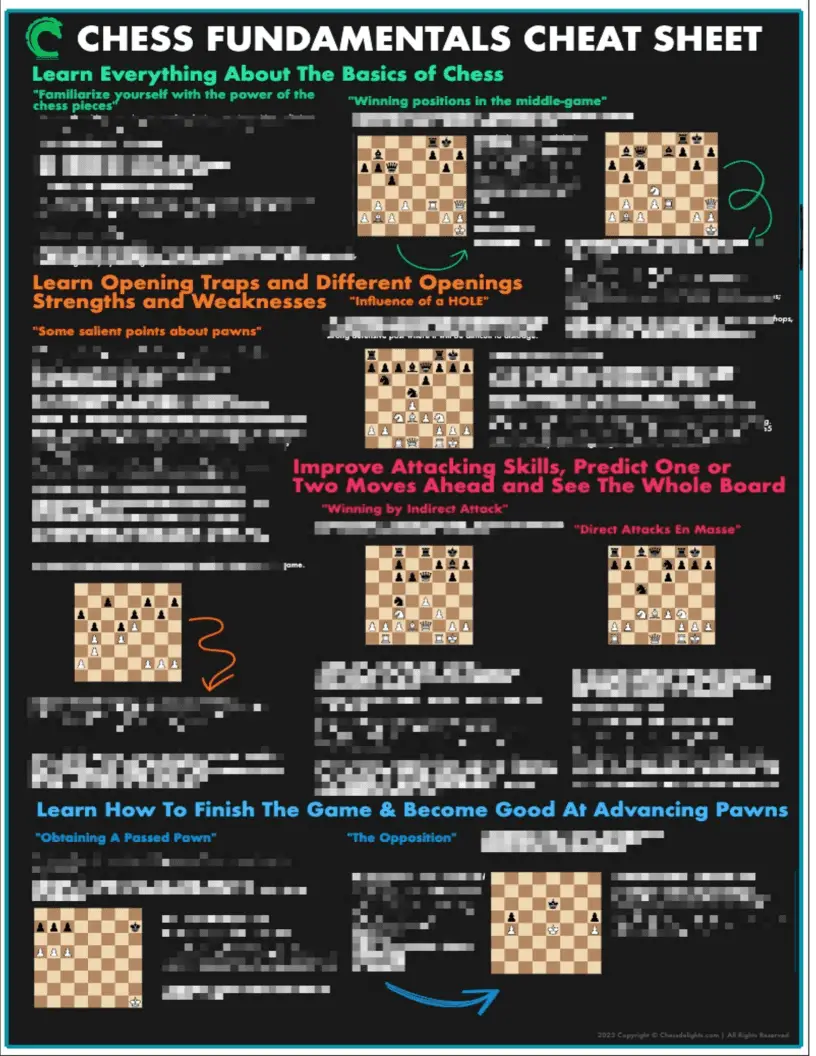
«Discover The Solution On How To Improve Your Game Faster» (Even If You’re Just Starting Out And You Don’t Know Where To Find The Answer!)
Also Get Your FREE «Chess Fundamentals Cheat Sheets» to help you SPEED UP Your Learning and more!
Click Here To Get Started
Keep Reading
♖ «It’s easy to get obsessed with chess. That’s what happened with Fischer and Paul Morphy. I don’t have that same obsession.»
-Magnus Carlsen (as interviewed in Time magazine) ♖
- Digital Clock Types:
- Chronos Standard
- Chronos Blitz
- Excalibur
- Saitek GameClockII
- Saitek Gameclock
- Saitek Mephisto
- ZMF II
- ZMF-Pro
- DGT North American
- DGT (FIDE)
- DGT 960
- DGT 1001
- Leap PQ9907
- Leap PQ9907S
- Leap PQ9903
- VTek 300
Popular Digital Chess Clock Manuals
Players should know how to:
- Set their clocks
- Pause during play
- Resume play
- Add time
- Set delay
- Set increment
- Explain these functions

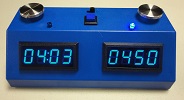
Due to the recent proliferation & variety of digital chess clocks as well as the USCF preference for digital clocks over analog clocks for rated games combined with a high percentage of players who still do not fully understand the operation & programming functions of their own clocks, this page contains User Manuals in readable & downloadable files of as many digital chess clocks as I can find. At this time I’m sure the list is incomplete, but I’ve tried to focus first on the most common types of digital clocks in use in USCF rated tournaments today.
There is some obsolete but interesting information about chess clocks in general in this document produced by TheChessHouse: how_to_chessclocks.PDF
Note however that some of the references to rules & customs in «how_to_chessclocks.PDF» are incorrect in light of the current USCF rules!
These user manuals are posted here as .PDF files which are readable using Adobe Reader. If you don’t have Adobe Reader, you can download it for free at:
http://get.adobe.com/reader/?promoid=DJDVP
How to set the Saitek Pro (gray) clock for G/100 d5
There is some useful background information, including the historical development of electronic chess clocks, & accurate definitions of «Fischer», «Bronstein», & «simple delay» modes on the Wikipedia «Chess Clock» page. Here’s a brief excerpt:
Fischer = before a player has made their move, a specified time increment is added to their clock. Time can be accumulated, so if the player moves within the delay period, their remaining time actually increases. For example, if the delay time is five seconds, and a player has four seconds left on their clock, as soon as their opponent moves, they receive the increment and has nine seconds to make a move. If they take two seconds to move, on the start of their next move they have twelve seconds. There is also a variant of this time control that adds the delay after a player makes their move («Fischer after» or more commonly increment), so the delay is added to the player’s remaining time and is available for their next move. If however time runs out during their move, the game ends without the delay time being added. This variant prevents the player who is in time-trouble to take advantage of the extra-time.
Bronstein delay = with the Bronstein timing method, the increment is always added after the move. But unlike Fischer, not always the maximum increment is added. If a player expends more than the specified increment, then the entire increment is added to the player’s clock. But if a player has moved faster than the time increment, only the exact amount of time expended by the player is added. For example, if the delay is five seconds, the player has ten seconds left in their clock before their turn and during their turn they spend three seconds, after they press the clock button to indicate the end of their turn, their clock increases by only three seconds (not five). This ensures that the time left on the clock can never increase, even if a player makes fast moves.
Simple delay = when it becomes a player’s turn to move, the clock waits for the delay period before starting to subtract from the player’s remaining time. For example, if the delay is five seconds, the clock waits for five seconds before counting down. The time is not accumulated. If the player moves within the delay period, no time is subtracted from their remaining time. This time control is similar to a Bronstein with time added before the move.
The September 2016 (70th Anniversary) issue of Chess Life contains an excellent article on chess clocks wherein it is mentioned that both Saitek Mephisto & Scholastic Blue clocks are no longer in production.
Reminder: Your digital electronic chess clock doesn’t like the cold either!
«In surface-mount designs, the differential temperature coefficient of expansion between the parts-soldered-to-the-circuit-board and the circuit board can cause large stresses. The stress-strain-temperature relationship often barely works over the specified temperature range. When the equipment is powered up, the hot components can change shape and break the brittle plastic, much like my old ice chest.»
«If the equipment is below zero degrees C [32 degrees F] and then you take it into a nice warm, humid office, water will condense on the circuit boards and can cause problems. Presumably a similar thing can happen with frost, depending on the weather. When the frost melts, there can be problems.»
For more info, refer to:
Storing electronics at low temperatures
Operating electronics at low temperaturesMost electronic chess clocks are difficult &/or expensive to repair, so don’t leave your clock in your car overnight!
Chronos
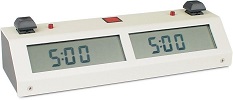 ChronosManual.pdf |
|
The Chronos (a.k.a. Chronos II, or Chronos Standard) is considered by many to be the best digital chess clock ever made. They are reliable, rugged & extremely flexible for programming functions. However, in addition to being somewhat confusing to program initially, they are a bit pricey & they have a history of being only internittently available even through major distributors. Chronos Clocks come in either a black, blue or beige metal case.
The Chronos clocks have 68 preset modes from which to choose. Each of these presets can be customized & saved into one of twelve user selectable presets. This may seem overwhelming at first, but in fact you’ll find the vast majority of users rarely use more than four or five presets, & once these are set up, operation is simple & minor modifications are easy.
You can watch a six minute video on YouTube explaining how to set up a few typical user programs for your Chronos clock here: YouTube Video, «How to set the Chronos Chess Clock II». This will get you started & after you’ve set up a few presets for your favorite time controls, you’ll most likely rarely if ever have to do any programming beyond occasionally changing a delay or beeper setting, which is really easy to do.
Back in December of 1999, Mark Kaprielian at Metrowewst Chess Club published a document «designed to help make sense of the many options available to the owners of the Chronos Clock». This document was revised in March of 2003 & posted on the MWCC site as Chronos_Clock_Tips.htm. A reformatted version with some minor typos corrected is presented here: MK-ChronosTips.html
Since FIDE time controls with increments are becoming more prevalent (in particular both RelyeaChess & Continental Chess Association frequently require increment time controls) & most typical club clock settings involve only delays,
instructions on how to set your Chronos clock for 40/90 SD30 inc30 for FIDE tournaments are presented here.
Chronos Blitz a.k.a. Chronos GX
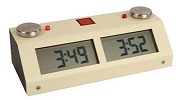 ChronosBlitzManual.pdf |
|
The Chronos GX, or «Blitz» Model is almost identical to the Chronos Standard Clock except that the Blitz version has a shorter case & a smaller display which does not show the move counter. Both types of Chronos Clocks may have either buttons or touch sensitive pads for clock operation. The Chronos Blitz Clocks come in a variety of colors including black, beige, blue, & yellow.
Since FIDE time controls with increments are becoming more prevalent (in particular both RelyeaChess & Continental Chess association frequently require increment time controls) & most typical club clock settings involve only delays,
instructions on how to set your Chronos clock for 40/90 SD30 inc30 for FIDE tournaments are presented here.
If you are somewhat put off by the explanations offered in the abridged manual for the Chronos Model GX, you’re not alone. However, I find the Blitz/GX model is actually easier to program than the standard model primarily because both the delay & increment settings are available in all of the «tournament» settings, so if you are using either delay or increment, but not both, yoou can just set the unused parameter to zero.
The good news is that all these features are explained on a couple YouTube videos. Here are two I like:
The complete set up guide to the Chronos GX 9:09
Chronos GX — how to access blitz and tournament modes 6:11
Take your pick, or watch both & you’ll soon be a Chronos GX Xepert!
Excalibur
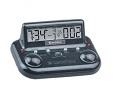 ExcaliburClockManual.pdf |
|
Excalibur GameTime Model 750 GT-II
Saitek GameClock II
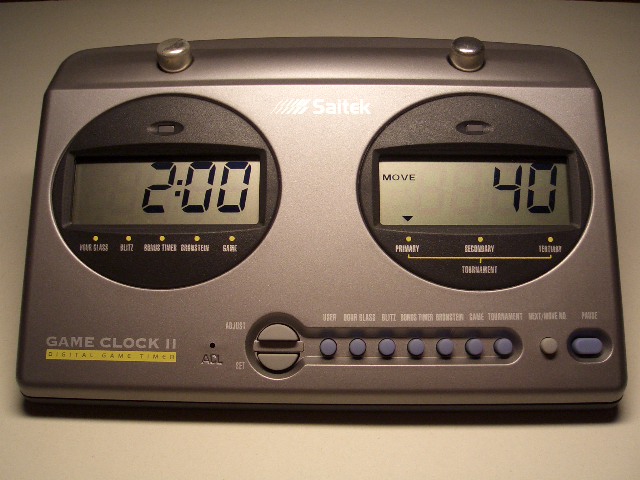 SaitekGC2Manual.pdf |
|
The Saitek Game Clock II has a row of buttons that allow direct easy access to all functions. Saitek: «Game Clock II» is an older moder, but may be nearly identical in function to the «Competition Game Clock (Scholastic Blue)», «Competition Pro Game Clock (Silver)», & «Competition Pro Game Clock III», which all appear to be different names for the same clock.
Saitek Gameclock
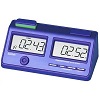 SaitekGameclockManual.pdf |
|
The Saitek Competition game clock has illuminated buttons that glow green when it’s your move & flash red when time has expired. Saitek: «Game Clock II», «Competition Game Clock (Scholastic Blue)», «Competition Pro Game Clock (Silver)», & «Competition Pro Game Clock III» all appear to be different names for the same clock.
Saitek Mephisto
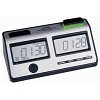 SaitekGameclockManual.pdf |
|
The Saitek Mephisto Competition Game Clock Pro (I believe this is the same clock as the Saitek «Competition Pro Game Clock [III or Silver]» mentioned above.) has illuminated buttons that glow green when it’s your move & flash red when time has expired. They are visible from all directions. Modes include: Hourglass, Blitz, & FIDE/ECU/Traditional Tournament as well as Fischer, Bronstein, Delay and Word Modes.
ZMF II
 ZMF-IIManual.pdf |
|
ZmartFun Electronics, Inc. are the proud USA producers of these elegant but simple game timers. They are currently available in black, blue, red, & green with bright white, blue, red, & green LED displays respectively. Like many more expensive clocks, they can be easily set for delay, increment, hour-glass, and byo-yomi timing modes as needed.
ZMF-Pro Blue Metal Case
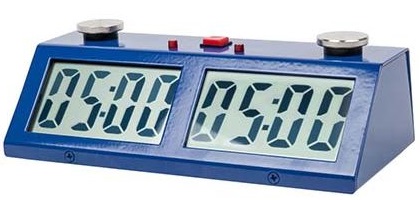 ZMF-ProManual.pdf |
|
ZmartFun Electronics, Inc. are the proud USA producers of these elegant but simple game timers. They are currently available in black, blue, & silver with large LCD displays. Like many more expensive clocks, they can be easily set for delay, increment, hour-glass, and byo-yomi timing modes as needed.
Note: As of May 15, 2018, there seems to be no user manual for the ZMF-Pro Metal case style clock. The newest manual available from Zmart Fun is v2.1 dated 09-07-15. It appears to be an updated version of the older ZMF II manual v1.4 dated 04-18-13. Until Zmart Fun issues a manual that explicitly addresses the newer ZMF-Pro Metal Case LCD style clocks, I’ll assume the operation of these clocks is the same as the newer ZMF II style clocks (i.e. v2.1).
DGT North American
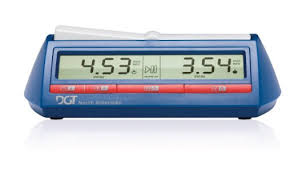 DGTNAManual.pdf |
|
This is the recently released North American version of the DGT Timer. Like the FIDE version, it may be used in conjunction with a DGT Recording Electronic Chess Board. LCD Display, Two AA Batteries, ABS Plastic Case, 34 Operating Modes. The LCD Contrast is adjustable to accommodate different lighting conditions. This clock does store your personal settings, but in order to start a new game, it seems you must turn the clock off then back on & scroll through the presets to find your desired mode.
According to the actual manual for this clock:
The main difference between the DGT2010 and the DGT North American (DGT NA) is the way the delay time is displayed and the color of the cabinet.
The DGT2010 adds the remaining delay time back for the player’s next turn, while the DGT NA pauses during the delay time, which is common in North American countries.
The result is exactly the same, only the way of displaying is different.
(The Fide Laws of Chess state the following: [The difference between the «Bronstein Mode» & the «Delay Mode»]6.2. b. The time saved by a player during one period is added to his time available for the next period, except in the ‘time delay’ mode.
In the time delay mode both players receive an allotted ‘main thinking time’. Each player also receives a ‘fixed extra time’ with every move. The countdown of the main time only commences after the fixed time has expired. Provided the player stops his clock before the expiration of the fixed time, the main thinking time does not change, irrespective of the proportion of the fixed time used.)The DGT NA has less presets for different timing methods and it has no special Go and Scrabble timing methods.
The DGT North American is not FIDE approved but all options that the DGT NA has in common with the DGT2010 are according to FIDE rules and regulations.
DGT (FIDE) [a.k.a. DGT-2010]
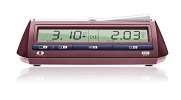 DGTManual.pdf |
|
The DGT Timer is the official chess clock of FIDE & may be used in conjunction with a DGT Recording Electronic Chess Board. LCD Display, Two AA Batteries, ABS Plastic Case, 34 Operating Modes. The LCD Contrast is adjustable to accommodate different lighting conditions. This clock does store your personal settings, but in order to start a new game, it seems you must turn the clock off then back on & scroll through the presets to find your desired mode.
A special DGT2010 Limited Edition is released in January 2013 to celebrate DGT’s 20 year anniversary. It was produced in 2013 only.
The Limited Edition has the same options as the popular DGT2010 but is designed in a celebratory red colour.
DGT 960
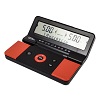 DGT960Manual.pdf |
|
The DGT 960 Timer is specifically designed to support not only typical chess & other game tournaments, but also the «fischer Random» or «Chess 960» variant which requires shuffling the pieces to generate the initial starting position. LCD Display, similar to the Standard DGT Clock above, features adjustable contrast for varying lighting conditions. The DGT 960 is far too tiny for anything like Size C or even AA batteries, so comes with a pre-installed small 3v CR2032 battery that will supposedly last for four years with average use of the sound signal. manufactured in The Netherlands, this clock is an excellent choice for someone wanting to travel light or play lots of Chess 960.
DGT 1001
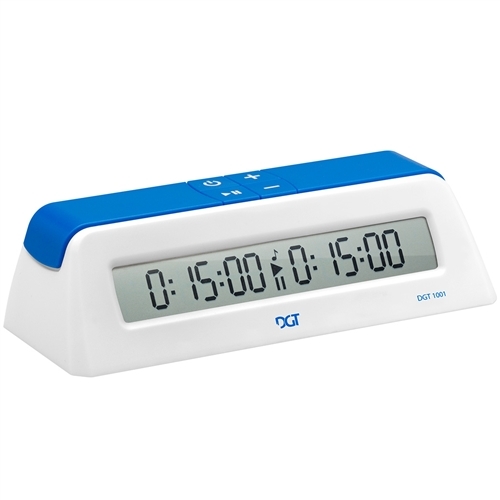 DGT960Manual.pdf |
|
The DGT 1001 is a universal game timer suitable for school, club or home use. It has a crystal clear display, is extremely easy to use and very affordable. The DGT 1001 features countdown and up-count and has two large buttons on the top left and right to operate the timer.
It comes in two color versions. Battery is included. Please see the manual for more information.
The DGT 1001 does NOT include a delay feature, increment time or multiple time controls.
Important Note:
This Clock does not have Time Delay and is not recommended for US Chess Federation Rated Play.
Leap PQ9907
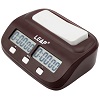 LeapPQ9907Manual.pdf |
|
Made in Guangdong, China. I’ve only seen a few of these Leap clocks, & they look like an inexpensive version of the DGT to me except they have no provision for connection to an external electronic chess board & they appear to be available in only one color. Actual dimensions are 13.5cm x 9.5cm x 4.5cm & the weight is 135g. They come with a user manual, but I haven’t found one online yet.
Note: Hugh McLaughlin informs me that:
«The Leap PQ9903B clock has the necessary features to provide the 5-sec delay that the WCC uses [as do many other rated tournaments]. The less expensive PQ9907, which has only three buttons below the display, does NOT have the delay capability.»
Leap PQ9907S
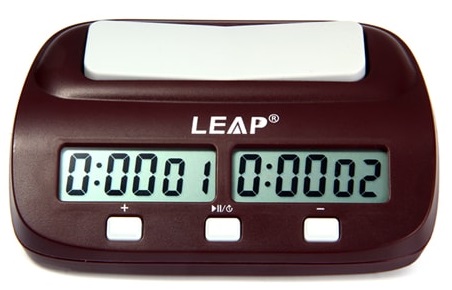 LeapPQ9907Manual.pdf |
|
Made in Guangdong, China. I’ve only seen a few of these Leap clocks, & they look like an inexpensive (~$15-$20 US) version of the DGT to me except they have no provision for connection to an external electronic chess board & they appear to be available in only one color. Actual dimensions are 13.5cm x 9.5cm x 4.5cm & the weight is 135g. They come with a user manual, but I haven’t found one online yet.
Note: Joerg Sonnenberger informs me that:
«The Leap PQ9907S is a slightly newer version of the 9907 you have on the list. The biggest difference is that it (PQ9907S) supports both Fischer time and simple delay mode. It can not do both bonus and delay settings at the same time though.
From the low end spectrum, I consider it much more useful than the entrance-level DGT models as it (PQ9907S) has full time control. We tend to play children tournaments with 2 minute penalties for the first two illegal moves and that’s downright impossible with the ‘DGT Easy’ and somewhat annoying with the ‘DGT 1001’.»
Leap PQ9903
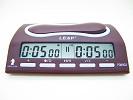 |
|
| Page 1 | Page 2 | Page 3 | Page 4 | Page 5 | Page 6 |
| Page 7 | Page 8 | Page 9 | Page 10 | Page 11 | Page 12 |
Made in Guangdong, China. I’ve never seen either one of these Leap clocks, [UPDATE: I’ve seen numerous specimens of both types of Leap clocks.] but they look like an inexpensive version of the DGT to me except they have no provision for connection to an external electronic chess board & they appear to be available in only one color.
VTek 300
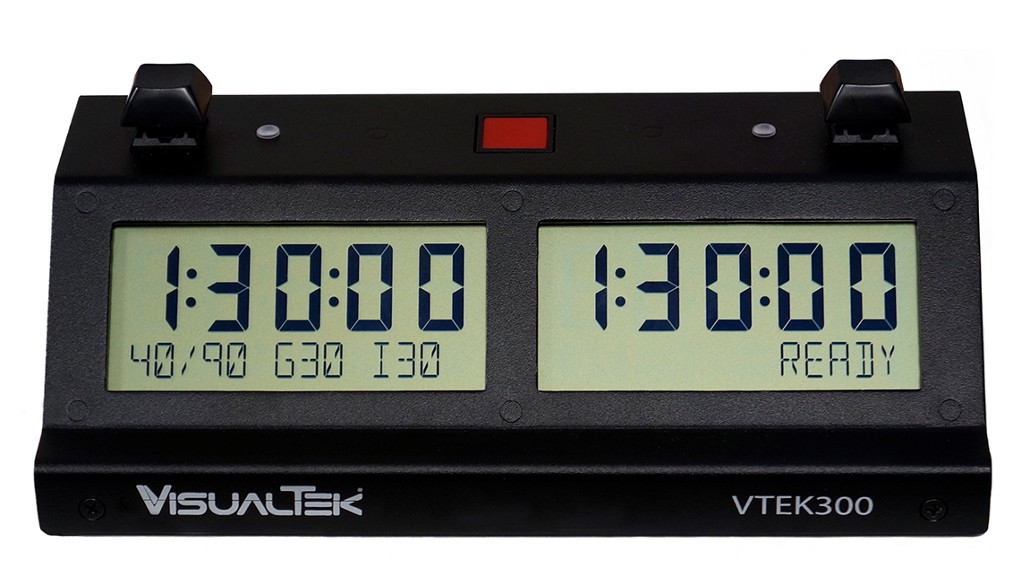 VTek300Manual.pdf |
|
«The VTEK 300 clock is the ultimate chess game clock. The large, clear display shows all the information chess players expect during play and while adjusting settings.
Setting is very intuitive and you’ll feel comfortable with it in less than 10 minutes. It is designed and made in USA by experienced engineers, advised by chess players who know what a clock needs.
For those familiar with the Chronos Chess Clock, we find that this clock beats the Chronos in almost every aspect of design.
The battery life is exceptional, options are thorough and well organized. It even has multi-function lights. It’s everything a player needs and then some, but without the perplexing programming. It’s just easier.
850 hours of game play is estimated on 3 AA batteries. When in idle mode they should last more than 2 years. When about 12 hours of game play are remaining, a low battery warning will show. There is an easy to access battery compartment with two Philips screws. Of course, it is recommended to remove the batteries if not being used for more than a year.»


Шахматные часы модель PQ9907S. Качественная и популярная модель. Имеются все необходимые программы для начинающих и полупрофессиональных шахматистов. Большая удобная кнопка переключения хода. Лёгкое нажатие с защитой от случайного переключения. Имеется отсчет времени, до 10 часов, а так же настраиваемый обратный отсчет. Звуковой сигнал при окончании матча. Контроль времени с добавлением Фишера. Инструкция. Интуитивное и понятное управление, работает от одной батарейки. Дополнительно в комплект входит батарейка.
*Ответ будет опубликован на сайте и продублирован на почту
Фильтр вопросов по темам:
Вопрос:
Здравствуйте! Реально ли фотографии соответствуют действительности?
Ответ:
Андрей, здравствуйте! В основном всё соответствует, да бывают случаи когда производители без предупреждения немного изменяют рисунок или цвет, но это бывает крайне редко. Стараемся за этим тщательно следить. В любом случаем не стоит нам верить на слово , а просто перед оплатой обязательно вскройте посылку и убедитесь что всё соответствует.
Вопрос:
Здравствуйте. Правильно ли у Вас указана цена за эти часы 198р.?
Ответ:
Здравствуйте. Цена указана не правильно, сейчас всё исправили.
Вопрос:
Доставка в Брянск сколько будет стоить?
Ответ:
Здравствуйте! Если отправить в пункт выдачи СДЭК то 250 рублей
Вопрос:
А в Крым вы тоже можете отправить?
Ответ:
Нина, здравствуйте! Да в Крым можем отправить как почтой России, так и СДЭК-ом.
Вопрос:
Скажите, пожалуйста, можете ли Вы отправить товар в Беларусь?
Ответ:
Олеся, здравствуйте! Да мы отправляем товары в Беларусь через курьерскую службу СДЭК, стоимость отправки в среднем 300 рублей и зависит от веса посылки.
Вопрос:
Есть ли самовывоз?
Ответ:
Павел, здравствуйте! У нас склад находится в г. Иваново на ул. Спартака д. 22 от туда Вы можете забрать товар бесплатно.
Отличный таймер! Очень доволен покупкой. Хороший магазин, отгрузили товар быстро, адекватно и грамотно согласовали всё по телефону. Приятно с такими профессионалами работать !
Ответ администрации:
Здравствуйте, Илья. Нам лестно слышать подобные отзывы. Самое главное для нас, чтобы клиент остался доволен нашей продукцией. Спасибо!
Дмитрий / 30.10.2018 /
Оценка:
Часы просты в управления, разобрался за две минуты. Рекомендую именно эту модель за простоту, надёжность и адекватную цену!
Надежда / 29.01.2019 /
Оценка:
Прекрасная работа: заказ пришел быстро, шахматные часы как раз, то что надо. Очень понравилось, что при предоплате есть скидка. Пожелание: сделайте ассортимент товаров побольше. Например, сувениры на шахматную тематику. Нам в школе регулярно они нужны.
Дмитрий / 04.02.2020 /
Оценка:
Спасибо за эти часы. Просты в управлении. Надежны. По сути брали «кота в мешке» для проведения областных соревнований — не прогадали. Соревнования прошли на достойном уровне. Спасибо Вам еще раз.
Сергей / 09.02.2020 /
Оценка:
Часы-то что было нужно. Команда работает хорошо и быстро. Спасибо.
Елена / 14.02.2020 /
Оценка:
Сделала заказ, в течение получаса мне перезвонили и все согласовали по телефону. На следующий день курьер привез в назначенное время. Чек, упаковка… все отлично. Часы покупала для внука 6 лет, занимается шахматами. Покупкой довольна. Спасибо работникам магазина за четкую работу.
